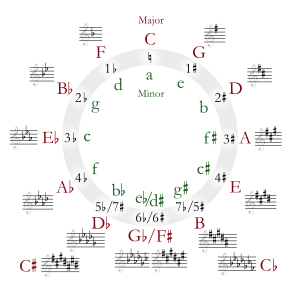E minor facts for kids
 |
||
| Relative key | G major | |
|---|---|---|
| Parallel key | E major | |
| Notes in this scale | ||
| E, F♯, G, A, B, C, D, E | ||
- Also see: E major, or E-flat minor.
E minor (sometimes called Em or Mim) is a musical minor scale that starts on the note E. A musical scale is a set of notes played in a specific order. E minor has one sharp in its key signature, which is F♯. A key signature tells you which notes are sharp or flat in a piece of music. Its "relative major" key is G major, meaning they share the same notes.
E minor is a very popular key for classical guitar music. It fits the instrument well because when a guitar is tuned normally, four of its six strings are already part of the E minor chord. This makes it easy for guitarists to play. It's also a favorite key in heavy metal music. This is because the lowest note on a guitar is E, and this key lets musicians use that low E sound a lot.
The famous composer Felix Mendelssohn used E minor often in his music.
Famous Music in E Minor
Many well-known classical pieces have been written in the key of E minor. Here are some examples:
- Symphony No. 4 by Johannes Brahms
- Nocturne in E Minor by Frédéric Chopin
- Piano Concerto No. 1 by Frédéric Chopin
- Prelude in E Minor by Frédéric Chopin
- Symphony No. 9 "From the New World" by Antonín Dvořák
- Slavonic Dances No. 2 Op. 72 by Antonín Dvořák
- Cello Concerto by Edward Elgar
- Symphony No. 44 "Trauer" by Joseph Haydn
- Symphony No. 7 by Gustav Mahler
- Violin Concerto in E Minor by Felix Mendelssohn
- Caprice No. 3 by Nicolò Paganini
- Symphony No. 2 by Sergei Rachmaninov
- Vocalise Op. 34 No. 14 by Sergei Rachmaninov
- Symphony No. 10 by Dmitri Shostakovich
- Symphony No. 1 by Jean Sibelius
- Symphony No. 5 by Tchaikovsky
- Symphony No. 6 by Ralph Vaughan Williams
- Concerto for Bassoon, Strings, and continuo, RV 484 by Antonio Vivaldi
See also: List of symphonies in E minor
Understanding Scales and Keys
| Diatonic Scales and Keys | |||||||||||||||||||||||||||||||||||||||||||||||||||||||
|---|---|---|---|---|---|---|---|---|---|---|---|---|---|---|---|---|---|---|---|---|---|---|---|---|---|---|---|---|---|---|---|---|---|---|---|---|---|---|---|---|---|---|---|---|---|---|---|---|---|---|---|---|---|---|---|
|
|||||||||||||||||||||||||||||||||||||||||||||||||||||||
| The table shows the number of sharps or flats in each scale. Minor scales are written in lower case. | |||||||||||||||||||||||||||||||||||||||||||||||||||||||
In music, a "key" is a group of notes that sound good together. It gives a piece of music its main feeling or mood. E minor, like other minor keys, often sounds a bit sad, serious, or thoughtful. Major keys, like G major, usually sound brighter and happier. The Circle of fifths is a diagram that shows how all the different musical keys are related to each other.
See also
 In Spanish: Mi menor para niños
In Spanish: Mi menor para niños


